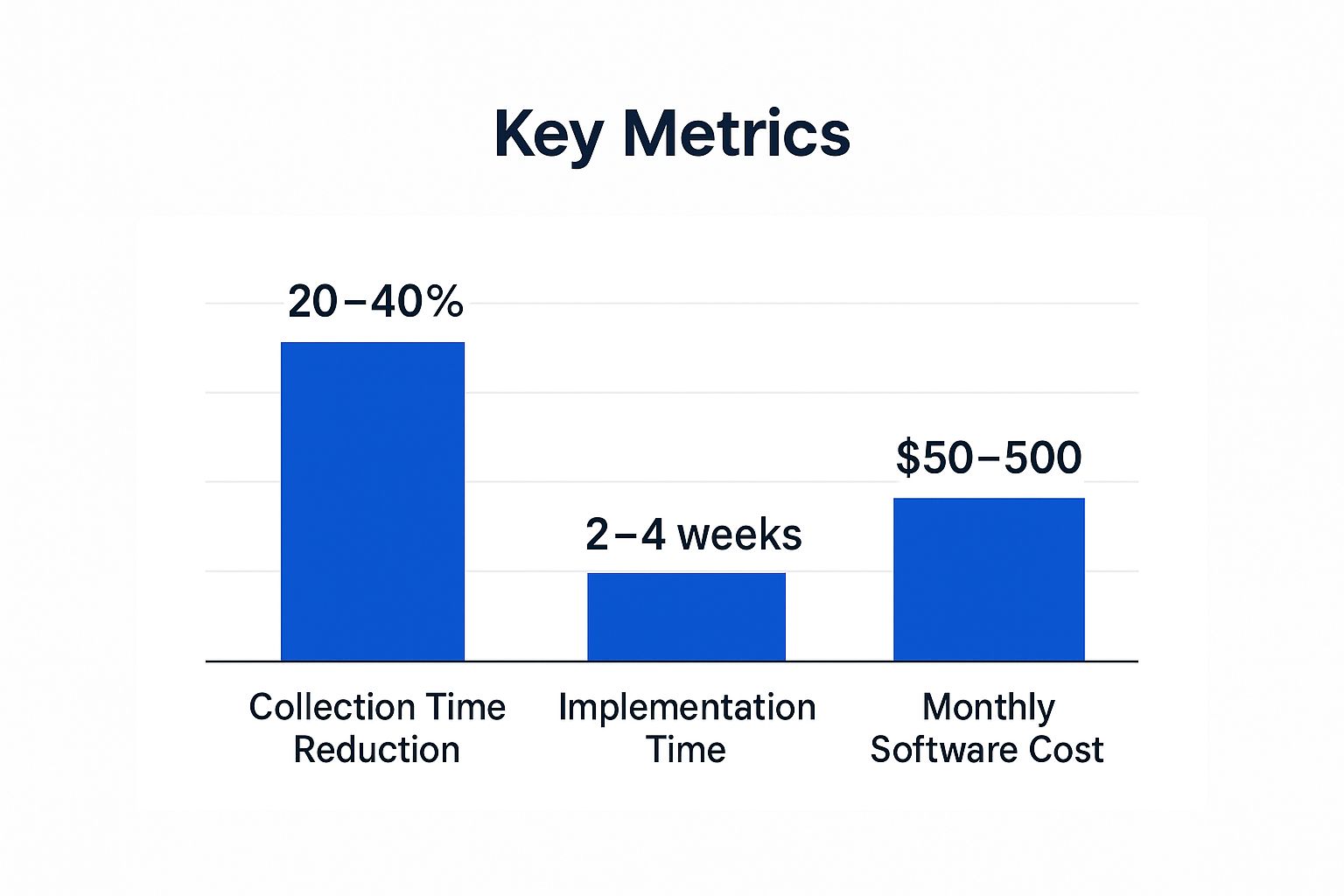In the world of business, profit may be the measure of success, but cash is the lifeblood. A company showing healthy profits on paper can still face significant challenges if it cannot manage its cash flow effectively. Poor liquidity stifles growth, prevents crucial investments, and can ultimately lead to insolvency. Mastering the inflow and outflow of money is not merely good practice; it is fundamental to survival and long-term prosperity. This guide moves beyond generic advice to provide tangible, actionable ways to improve cash flow for your organisation.
We will explore concrete strategies ranging from optimising your accounts receivable and managing payables to implementing dynamic pricing models and strategic cost-cutting. You will also learn about financing options and restructuring debt. For many businesses, securing external funding is a key component of this strategy, so understanding topics like how to apply for a business loan is vital for leveraging capital effectively. This article delivers a robust toolkit designed to strengthen your company's financial foundation. By implementing these practical techniques, you can ensure you have the necessary liquidity to not only navigate challenges but also seize opportunities for sustainable growth.
1. Accelerate Accounts Receivable Collection
One of the most direct ways to improve cash flow is to reduce the time it takes to get paid for your products or services. Accelerating your accounts receivable (AR) collection means systematically closing the gap between invoicing a customer and receiving the funds. This isn't about hassling clients; it's about creating an efficient, professional process that encourages prompt payment and keeps your business liquid.
When you convert sales into cash faster, you have more working capital available for operations, growth, and unexpected expenses. A professional services firm, for example, improved its monthly cash flow by £40,000 simply by offering a 2% discount for payments made within 10 days. This proactive approach turns outstanding invoices into a reliable source of immediate funds.
How to Implement Faster AR Collection
Implementing an efficient AR process is a high-impact, low-cost strategy. The following bar chart visualises the typical investment and return for small businesses.

The chart highlights that with a modest monthly investment and a setup time of only a few weeks, businesses can achieve a significant reduction in collection times. To get started, consider these actionable tips:
- Set Clear Terms: Establish payment terms like Net 15 or Net 30 upfront and ensure they are clearly stated on every invoice.
- Invoice Immediately: Send invoices as soon as work is completed or products are delivered. Delays in billing directly cause delays in payment.
- Automate Reminders: Use accounting software (like QuickBooks or Xero) to send automated payment reminders at set intervals, such as 7, 14, and 21 days past the due date.
- Offer Multiple Payment Options: Make it easy for customers to pay by accepting bank transfers, credit cards, and online payment gateways.
For many small and medium-sized enterprises, managing these details consistently can be a challenge. If your team is stretched thin, explore how outsourced bookkeeping services can help you streamline your invoicing and collections process, freeing up valuable time while ensuring your cash flow remains healthy.
2. Strategic Inventory Management Optimisation
Holding excess inventory is like tying up cash in a warehouse. Strategic inventory management is a data-driven approach that ensures you have just enough stock to meet demand without overinvesting. This optimisation process involves techniques like just-in-time ordering, demand forecasting, and ABC analysis to balance customer satisfaction with financial liquidity. It's a critical way to improve cash flow by unlocking capital that would otherwise be sitting idle on your shelves.
By fine-tuning stock levels, businesses can significantly reduce holding costs, minimise waste from obsolete products, and free up funds for operations or growth. For instance, a small retailer using ABC analysis freed up £100,000 in cash by focusing its inventory investment on high-turnover items. This approach transforms inventory from a cash drain into a lean, efficient asset.
How to Optimise Your Inventory Management
Implementing a strategic inventory system requires a commitment to data analysis but delivers substantial returns by improving your cash conversion cycle.

The key is to use real-time data to make smarter purchasing decisions. To get started, consider these actionable tips:
- Implement ABC Analysis: Categorise your inventory into A, B, and C groups. 'A' items are high-value and fast-moving, requiring close monitoring, while 'C' items are low-value and can be managed less frequently.
- Use Demand Forecasting: Analyse historical sales data and market trends to predict future demand accurately, preventing both stockouts and overstocking.
- Establish Reorder Points: Set minimum stock levels for each item that automatically trigger a new order, ensuring you never run out of popular products.
- Build Strong Supplier Relationships: Work with reliable suppliers who can offer quick turnaround times. This reduces the need to hold large amounts of safety stock.
This short video provides a clear overview of the just-in-time (JIT) method, a cornerstone of modern inventory management popularised by Toyota.
3. Extend Accounts Payable Strategically
While getting paid faster is crucial, another effective way to improve cash flow is to slow down how quickly you pay your own bills. Extending your accounts payable (AP) strategically means negotiating longer payment terms with your suppliers without damaging those valuable relationships or incurring late fees. This method essentially allows you to use your supplier's credit as a short-term, interest-free loan, keeping cash in your business for longer.
This isn't about avoiding payments; it's about optimising payment cycles to your advantage. For instance, a manufacturing company that successfully renegotiated its terms with a key supplier from Net 30 to Net 45 instantly improved its operational cash flow by over £200,000. By holding onto that cash for an extra 15 days each cycle, it could cover payroll and invest in raw materials without needing to dip into its overdraft facility.
How to Implement Strategic AP Extension
Successfully extending payment terms requires trust and clear communication with your suppliers. It's a balancing act between optimising your cash position and maintaining strong, reliable partnerships that are vital for your operations. To approach this effectively, consider these actionable steps:
- Prioritise Long-Term Partners: Approach your most established and trusted suppliers first. A long history of reliable payments gives you the leverage to ask for more flexible terms.
- Offer a Quid Pro Quo: Frame your request as a mutual benefit. Offer something in return for longer terms, such as a larger order volume, a longer-term contract, or faster order processing on your end.
- Honour Your Agreements: Once new terms are agreed upon, always pay within that new timeframe. Breaching these terms can destroy trust and may result in your credit being revoked entirely.
- Analyse Early Payment Discounts: Carefully calculate whether an early payment discount is worth taking. Sometimes, the cash flow benefit of holding onto your money for longer outweighs the small percentage you might save.
4. Dynamic Pricing and Revenue Optimization
Beyond static price lists, dynamic pricing offers a sophisticated way to improve cash flow by adjusting prices in real time based on demand, market conditions, and customer behaviour. This strategy moves pricing from a fixed cost-plus model to a flexible, data-driven system designed to maximise revenue from every transaction. By strategically capturing the highest price a customer is willing to pay at any given moment, you can directly increase your cash intake.
For instance, airlines have mastered this for decades, achieving revenue improvements of 5-10% by adjusting ticket prices based on seat availability and booking time. Similarly, a SaaS company that implemented tiered pricing based on usage and features saw its average customer value increase by 25%. This approach turns your pricing strategy into a powerful, responsive tool for cash generation.
How to Implement Dynamic Pricing
Implementing dynamic pricing requires a commitment to data analysis but can yield substantial returns. The key is to start small and scale your efforts as you gather more insights into customer behaviour and market responses.
To get started with this effective way to improve cash flow, consider these actionable tips:
- Start with Small Adjustments: Begin by making minor price changes to test market sensitivity and customer response without causing major disruption.
- Utilise A/B Testing: Validate pricing hypotheses by offering different price points to different customer segments and measuring the impact on conversion and revenue.
- Monitor Competitors: Keep a close eye on how competitors react to your pricing changes and be prepared to adjust your strategy accordingly.
- Communicate Value Clearly: When increasing prices, ensure you clearly articulate the value and benefits customers receive to justify the change and maintain goodwill.
- Consider Bundling Strategies: Create product or service bundles that offer compelling value, allowing you to increase the average transaction value.
5. Cash Flow Forecasting and Planning
Anticipating financial needs is one of the most powerful ways to improve cash flow. Cash flow forecasting and planning involves creating a comprehensive model that predicts future cash inflows and outflows over various time horizons. This moves you from a reactive to a proactive financial stance, allowing you to foresee potential shortfalls and surpluses before they happen. It’s a crucial discipline for maintaining liquidity and making informed strategic decisions.
A manufacturing firm, for instance, used accurate forecasting to time a £150,000 equipment purchase during a projected cash surplus period, avoiding the need for costly external financing. This forward-looking approach transforms financial management from guesswork into a strategic advantage, ensuring your business has the right amount of cash at the right time.
How to Implement Cash Flow Forecasting
Building a reliable forecast is an essential, ongoing business process that provides clarity and control. The following chart illustrates the typical inputs and outputs of a well-structured cash flow forecasting system.

The chart demonstrates how historical data, sales pipelines, and expense budgets combine to produce actionable insights. To accurately predict future cash positions, leveraging a robust financial projections template is indispensable for businesses. Consider these tips to get started:
- Update Forecasts Regularly: Review and update your forecast at least weekly with actual results to maintain its accuracy and relevance.
- Use Conservative Assumptions: When projecting, be conservative with income estimates and more aggressive with expense predictions to create a realistic buffer.
- Create Multiple Scenarios: Develop best-case, worst-case, and most-likely scenarios to understand potential outcomes and prepare contingency plans.
- Track Accuracy: Monitor how your forecasts compare to actual results over time. Use this feedback to refine your assumptions and improve your methodology.
Integrating forecasting into your financial rhythm is a key component of effective management. When done correctly, this practice can help you streamline business processes by aligning operational decisions with financial realities, ensuring sustainable growth and stability.
6. Subscription and Recurring Revenue Models
Transforming one-time sales into predictable, recurring revenue is one of the most powerful ways to improve cash flow stability. A subscription model shifts your business from unpredictable transactions to a steady, forecastable income stream. This approach locks in future revenue, enhances customer lifetime value, and provides the financial consistency needed for strategic planning and growth.
This model fundamentally changes your financial outlook from reactive to proactive. For instance, Adobe’s transition from selling software licences to its Creative Cloud subscription increased its revenue by over 40% and created a more predictable financial foundation. A small accounting firm can achieve similar stability by converting project-based work into fixed monthly service plans, smoothing out its income and making cash flow management far easier.
How to Implement a Recurring Revenue Model
Shifting to a subscription-based service creates a reliable revenue floor, giving your business a buffer against market fluctuations. It turns a lumpy income stream into a smooth, predictable one. The key is to deliver ongoing value that justifies a recurring payment from your customers.
To make this transition successful, consider these actionable tips:
- Pilot Your Programme: Start with a small, targeted group of customers to test pricing, features, and overall acceptance before a full-scale launch.
- Offer Tiered Options: Create multiple subscription levels (e.g., basic, premium, enterprise) to cater to different customer needs and budgets, maximising your market reach.
- Focus on Onboarding: A seamless onboarding process is crucial for demonstrating immediate value and reducing the risk of early cancellation or "churn".
- Analyse Customer Behaviour: Use data analytics to understand how customers use your service, identify those at risk of leaving, and proactively intervene to retain them.
- Consider Hybrid Models: If a full subscription isn't feasible, combine a base recurring fee with usage-based charges to offer flexibility while still securing a predictable income.
7. Debt Restructuring and Refinancing
Debt restructuring is a strategic financial approach that can significantly improve cash flow by altering the terms of your existing debt obligations. The goal is to make debt service more manageable, either by lowering interest rates, extending repayment periods, or consolidating multiple debts into a single, more favourable loan. This frees up cash that would otherwise be tied up in expensive repayments, allowing you to reinvest it into core business operations.
For instance, a manufacturing company that extended its loan terms from five to seven years was able to free up £50,000 annually. Similarly, a retail business that consolidated multiple credit lines into a single term loan at a 3% lower interest rate unlocked substantial monthly savings. These actions reduce the immediate cash drain from debt service, providing critical liquidity without disrupting business continuity.
How to Implement Debt Restructuring
Successfully renegotiating debt requires careful preparation and proactive communication with lenders. It's a powerful tool for businesses facing temporary cash shortfalls or seeking to optimise their capital structure.
To begin the process, consider these actionable steps:
- Approach Lenders Early: Initiate discussions with your lenders before you miss any payments. Being proactive demonstrates responsibility and increases your chances of securing favourable terms.
- Prepare Detailed Financials: Develop comprehensive financial projections that clearly illustrate your business's ability to meet the new, restructured payment obligations. This builds lender confidence in your plan.
- Explore All Options: Shop around and get competitive offers from multiple lenders. Refinancing high-cost debt with a new, cheaper loan is often one of the best ways to improve cash flow.
- Maintain Open Communication: Keep all your lenders informed throughout the process. Transparency is crucial for maintaining good relationships and achieving a successful outcome.
When considering external funding as part of your restructuring strategy, it is essential to understand the underlying reasons businesses take unsecured loans and how different financing options can contribute to your overall liquidity goals.
8. Asset-Based Financing Solutions
When traditional bank loans are out of reach or too slow to secure, asset-based financing provides a powerful way to improve cash flow by unlocking the value tied up in your existing business assets. This strategy allows you to secure funding against accounts receivable, inventory, equipment, or even real estate, converting illiquid assets into immediate working capital. It's a practical solution for businesses that are asset-rich but cash-poor, enabling them to fund operations and growth without diluting equity.
This method offers a direct lifeline for companies needing rapid capital. For instance, a UK-based manufacturing company was able to fund a major expansion project by factoring £500,000 of its outstanding receivables. This move provided the immediate cash injection needed to purchase new machinery and hire staff, directly converting unpaid invoices into a catalyst for growth and improving its cash position significantly.
How to Implement Asset-Based Financing
Successfully leveraging your assets for financing requires careful planning and a clear understanding of the process. While it provides quick access to funds, it's crucial to partner with the right lender and manage the facility effectively to maximise its benefits for your business.
To get started, consider these actionable tips:
- Understand Your Assets: Maintain detailed, up-to-date records of your assets, including accounts receivable ageing reports, inventory valuations, and equipment appraisals.
- Shop for Lenders: Compare terms from multiple asset-based lenders, including banks and specialised finance companies, to find the best rates and fees.
- Scrutinise the Agreement: Carefully review all costs, including interest rates, service fees, and any potential penalties. Ensure you understand the advance rate (the percentage of asset value you can borrow).
- Use Funds Strategically: Earmark the proceeds for specific growth initiatives or operational needs, such as fulfilling large orders, managing seasonal demand, or investing in new technology.
This approach is particularly valuable when you need to bridge a temporary cash flow gap or seize a growth opportunity that your current liquidity can't support. By monetising the assets you already own, you can create one of the most effective ways to improve cash flow without taking on traditional debt.
9. Expense Reduction and Cost Optimization
One of the most effective ways to improve cash flow is by systematically reducing business expenses. Cost optimisation is not about making indiscriminate cuts; it's a strategic analysis of where your money is going and finding ways to reduce cash outflows while maintaining or even improving operational quality. By being more deliberate with spending, you directly increase the cash available for investment, debt reduction, and navigating economic uncertainty.
A restaurant, for example, successfully reduced its food costs by 15% through a combination of better supplier negotiations and implementing a rigorous waste reduction programme. Similarly, a small business saved £50,000 annually by simply renegotiating its insurance, utilities, and software contracts. These examples show how proactive cost management directly boosts your bottom line and strengthens financial resilience.
How to Implement Expense Reduction
Implementing a cost optimisation strategy requires a disciplined approach to analysing and managing expenditures. The bar chart below illustrates the typical investment and return for businesses focusing on this area.

The chart shows that a commitment to ongoing analysis can yield substantial long-term savings. To begin optimising your expenses, consider these actionable steps:
- Conduct a Thorough Spend Analysis: Review at least 12 months of financial data to understand exactly where your money is being spent.
- Prioritise Large Expenses: Focus your initial efforts on the largest expense categories, such as rent, payroll, and supplier contracts, as small percentage savings here will have the biggest impact.
- Renegotiate with Suppliers: Don't be afraid to ask for better terms. Get multiple quotes for key services and use them as leverage to renegotiate existing contracts.
- Embrace Automation: Use technology to automate repetitive administrative tasks. A professional services firm, for instance, reduced its administrative costs by £30,000 by automating its invoicing process.
For businesses looking for a deeper dive into this topic, explore these expert strategies to reduce operating costs and see how targeted changes can lead to significant financial improvements and healthier cash flow.
9 Key Cash Flow Improvement Strategies Compared
Transforming Your Cash Flow from a Challenge into a Strategic Asset
Mastering your company's liquidity is not a single project with a finish line; it is an ongoing discipline that underpins sustainable success. The strategies detailed in this guide, from accelerating accounts receivable to optimising inventory and strategically managing payables, provide a comprehensive toolkit. These are not isolated fixes but interconnected components of a robust financial engine. By implementing these practical ways to improve cash flow, you transition from a reactive, often stressful, financial position to one of proactive control and strategic advantage.
The journey towards financial resilience is about making consistent, informed decisions. Each choice, whether it involves renegotiating payment terms with a supplier or refining your pricing model, contributes to a healthier cash position. This proactive management builds a crucial buffer, empowering your business to withstand economic downturns, seize unexpected opportunities, and invest confidently in future growth.
Your Actionable Path Forward
To translate this knowledge into tangible results, consider these immediate next steps:
- Conduct a Cash Flow Audit: Begin by analysing your current processes. Identify the biggest drains on your cash and the most significant opportunities for improvement based on the strategies we've discussed. Where are the bottlenecks in your receivables? Is your inventory tying up too much capital?
- Prioritise One or Two Initiatives: Avoid trying to overhaul everything at once. Select the two strategies that will deliver the most significant impact with the least initial resistance. Perhaps that's implementing new invoicing software or conducting a thorough expense review.
- Explore Strategic Cost Optimisation: Critically evaluate your largest operational expenses. For many businesses, payroll represents the most substantial cash outflow. Investigating a global talent strategy can be a transformative step in managing this cost centre effectively.
A Final Thought on Strategic Growth
Ultimately, effective cash flow management is the bedrock upon which all other business ambitions are built. It is the fuel for innovation, the safety net during uncertainty, and the key that unlocks scalable growth. As you implement these strategies, remember that optimising cash flow is not just about survival; it's about building a more resilient, agile, and powerful business. You are not just managing money; you are architecting the future of your enterprise.

